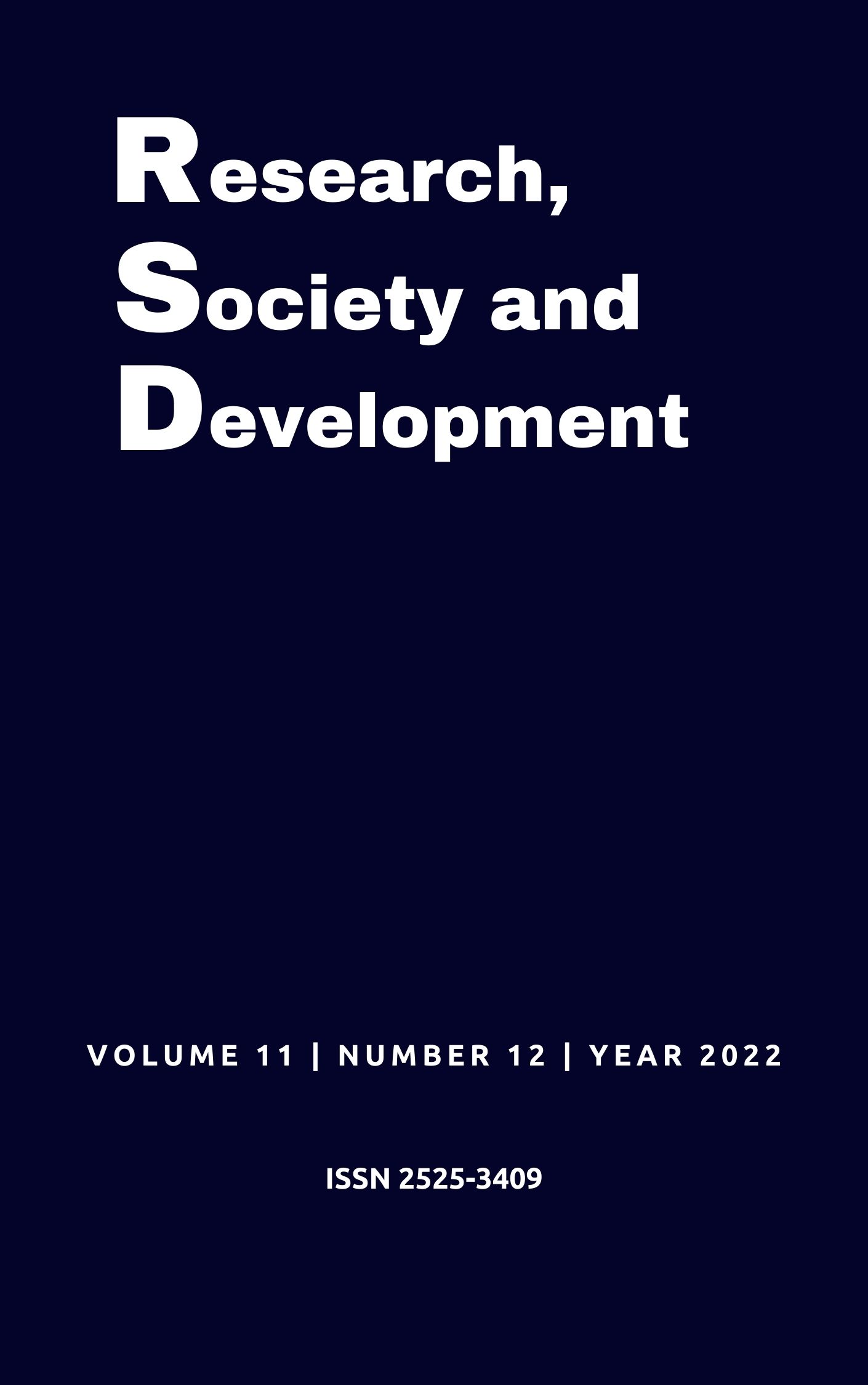Use of Fagopyrum esculentum and Ocimum basilicum to control laminar erosion, in Sorocaba-SP
DOI:
https://doi.org/10.33448/rsd-v11i12.33399Keywords:
Soil conservation; Cover plants; Soil loss; Water loss.Abstract
The use of land when well elaborated, promotes the possibility of minimizing harmful processes such as water erosion and promotes the good use of natural soil fertility. Among the forms of planning aimed at soil conservation there are those that are based on soil coating, thus the objective of this work was to evaluate the use of crops such as Fagopyrum esculentum (Buckwheat) and Ocimum basilicum (Basilicum) in the control of laminar erosion. In this sense, 03 plots containing different forms of implantation and 01 plot with exposed soil all with approximately 3.0 m², for the analyses simulated rainfall with intensity of 20mm, performing at the end of each simulation the collection of water and soil from laminar erosion in buckets allocated at the end of the plots, in addition, the crop cover index was monitored over time. The result showed that soil and water loss is inversely proportional to the cover index (r = -0.99), “Trigo Mourisco” and “Manjericão” tend to cover the soil between 2 and 5 weeks, respectively. Thus, the use of plants that allow soil coating promotes over time better use of its physical-chemical characteristics, improving local productivity for agricultural uses.
References
Bertoni, J. & Lombardi Neto, F. (2005). Conservação do solo. 5 ed. São Paulo: Ícone, 356p
Carvalho, D. F.; Montebeller, C. A., Cruz, E. S.; Ceddin, M. B.; Lana, A. M. Q. (2002). Perda de solo e água em Argissolo Vermelho Amarelo, submetido a diferentes intensidades de chuva simulada. Revista Brasileira de Engenharia Agrícola e Ambiental, Campina Grande, v.6, n.3, p.385-389.
Castro, N. E. Ar.; Silva, M. L. N.; Freitas, D. A.F.; Carvalho, G. J.; Marques, R. M., Gontijo Neto, G. F. (2011). Plantas de cobertura no controle da erosão hídrica sob chuvas naturais. Ufla, Lavras - Mg, p. 775-785.
Dechen, S. C. F. (2004). Manejo de solos tropicais no Brasil. REUNIÃO BRASILEIRA DE MANEJO E CONSERVAÇÃO DO SOLO E DA ÁGUA: manejo integrado a ciência do solo na produção de alimentos. Santa Maria - RS. UFSM, p.1-25.
Guerra, A. J. T; Silva, A S; Botelho, R G M. (2015) Erosão e conservação dos solos: conceitos, temas e aplicações. 10. ed. Rio de Janeiro: Bertrand Brasil, 339p.
Link, L. (2020). Plantas de cobertura de verão: crescimento e acúmulo de nutrientes, épocas de dessecação e produtividade do trigo. 62f. Dissertação (Mestrado em Agroecossistemas) - Programa de Pós-graduação em Agroecossistemas (Área de concentração: culturas anuais em sistemas integrados de produção), Universidade Tecnológica Federal do Paraná, Dois Vizinhos.
Luciano, R.V.; Bertol, 1.; Barbosa, F.T.; Vidal Vazquez, E.; Fabian, E.L. (2009) Perdas de água e solo por erosão hídrica em duas direções de semeadura de aveia e ervilhaca. R. Bras. CioSolo, 33: p. 669-676.
Maia, J. T. L. S; Martins, E. R; Costa, C. A; Ferraz, E. O. F; Alvarenga, I. C. A; Souza Júnior, I. T; Valadares, S. V. (2009). Influência do cultivo em consórcio na produção de fitomassa e óleo essencial de manjericão (Ocimum basilicum L.) e hortelã (Mentha x villosa Huds. ) / Influence of intercropping on phytomass and essential oil production in basil (Ocimum basilicum L.) and mint (Mentha x villosa Huds. ). Rev. bras. plantas med ; 11(2): 137-140
Mafra, N. M. C. (2009). Erosão e Planificação de Uso do Solo. In: Guerra, A.J.T; Silva, A.S; Garrido, B.R.(Org.). Erosão e Conservação de Solos: conceitos, temas e aplicação. 4ed.RIO DE JANEIRO: Editora Bertrand Brasil, p.301-322.
PIRES, F. R.; SOUZA, C. M.. Práticas mecânicas de conservação do solo e da água. 3. ed., rev. Viçosa, MG: Universidade Federal de Viçosa, 2013. 216 p.
Primavezi, A (2009) “Cartilha do Solo: como reconhecer e sanar seus problemas”. Fundação Mokiti Okada. 72p.
Pruski, Fernando Falco. (2009) Conservação de solo e água: práticas mecânicas para o controle da erosão hídrica. 2. ed., atual. ampl. Viçosa, MG: Universidade Federal de Viçosa, 279 p.
Teixeira, P. C., Misra, R. K. (1997). Erosion and sediment characteristics of cultivated forest soils as affected by the mechanical stability of aggregates. Catena. v.30, p. 199-134.
Sousa, L. A. Rodrigues; Molnar, A. G.; Costa, D. R. (2020). Influência do Amendoim Forrageiro (Arachis pintoi) e do Feijão-de-Porco (Canavalia ensiformis) como plantas de cobertura no controle de erosão hídrica sob chuva simulada. Agropecuária Científica no semi-árido, v. 16, p. 145-150.
Silva, E. N. (2016) Comportamento sazonal da ilha de calor e de frio em Sorocaba, São Paulo, Brasil. XII Sbcg, Goiânia, p. 3-4.
Sorotto, R.P.; Rosolem, C.A.; Crusciol C.A.C. (2011) Integração lavoura pecuária floresta: alguns exemplos no Brasil Central. Botucatu: FEPAF, 110p.
Downloads
Published
How to Cite
Issue
Section
License
Copyright (c) 2022 Tassiane Viana Barbosa; Gabriela Pereira Pirondi; Bertha Devora Agurto Berdejo de de Castro; Danilo Ribeiro da Costa

This work is licensed under a Creative Commons Attribution 4.0 International License.
Authors who publish with this journal agree to the following terms:
1) Authors retain copyright and grant the journal right of first publication with the work simultaneously licensed under a Creative Commons Attribution License that allows others to share the work with an acknowledgement of the work's authorship and initial publication in this journal.
2) Authors are able to enter into separate, additional contractual arrangements for the non-exclusive distribution of the journal's published version of the work (e.g., post it to an institutional repository or publish it in a book), with an acknowledgement of its initial publication in this journal.
3) Authors are permitted and encouraged to post their work online (e.g., in institutional repositories or on their website) prior to and during the submission process, as it can lead to productive exchanges, as well as earlier and greater citation of published work.

